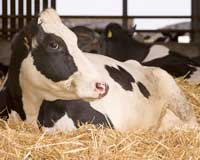Sand an option as straw bedding cost soars

Dairy farmers should resist the temptation to skimp on straw in an effort to save costs, or risk an increase in mastitis infections, according to DairyCo’s Hugh Black.
“Using less straw can impact on the number of dry cow mastitis cases and result in cows calving down with either clinical infections or raised cell counts.
“Sand is an alternative bedding material to straw that could be an option for many farmers. By switching to sand bedding you don’t need to compromise udder health and there are other benefits too.
“Sand doesn’t require a large amount of storage space and you can buy it in only when it’s needed. It helps cows to stay clean because it’s an inert material and won’t encourage bacterial growth.” Sand can be left for up to six months, provided it is well managed and maintained, where as straw should be mucked out once a month.
However, when a farmer decides to switch to sand, it is important to maintain adequate loafing area, ideally three square metres a cow. This is over and above the feed passage area required for feeding.
“Space allowance for the sand beds should be the same as straw bed space allowance – 1.25m2/1000 litres of production.”
For example, a 7000-litre cow requires 8.75m2 of lying area space allowance, and an 11,000-litre cow needs 13.75m2.
• More information on space allowance and housing needs can be found in the DairyCo publication Housing the 21st Century Cow, while bedding requirements are one of the areas addressed in the DairyCo Mastitis Control Plan.
